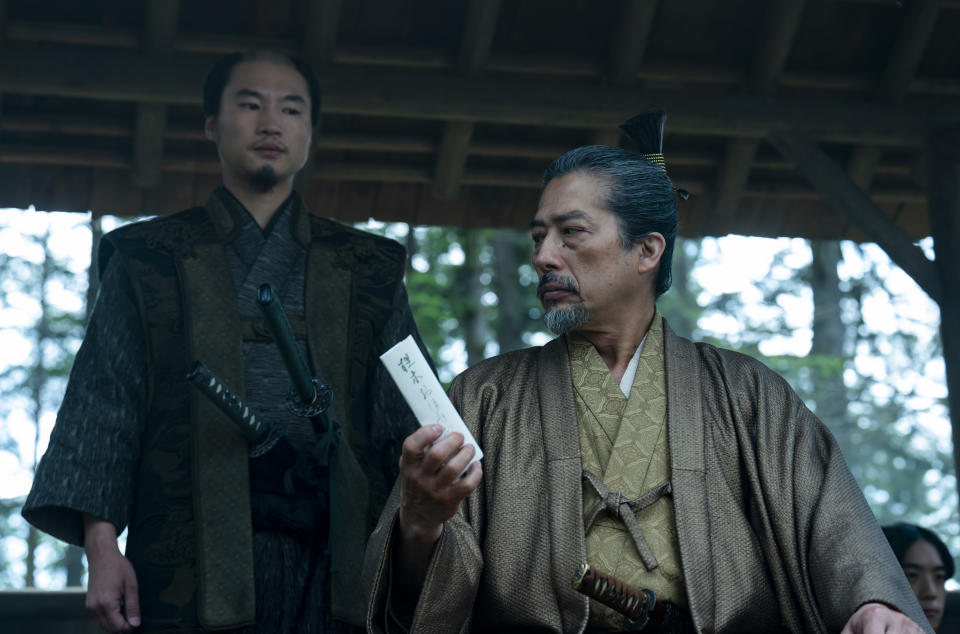‘Shogun’ Could Have Kept Going — and That Makes Its Ending Special

- Oops!Something went wrong.Please try again later.
Even though the warlord Toranaga’s (Hiroyuki Sanada) master plan to rule Japan is revealed by the end of “Shogun,” audiences who want to see more of how he shapes what will become the Edo Period aren’t alone. Co-creators Justin Marks and Rachel Kondo’s approach to the structure of the miniseries opened up a lot of doors that could be extremely tempting to walk through.
That’s because the “Shogun” writing team thought of each episode not as a set of steps towards a single climax punctuated by arbitrary cliffhangers. It was important to the “Shogun” team that every episode of the series stood on its own as a story that pushes its characters in some important way — not unlike a short story.
More from IndieWire
“I’m so drawn to the short story. There’s something about the art of the short story that feels difficult and worthy of the difficulty,” Kondo told IndieWire on the Filmmaker Toolkit podcast. “There has to be this sense of surprise by the end but also this sense of inevitability that, of course, it’s going to end this way. And I think we brought that sensibility to every episode and tried to contain them in that way.”
Marks particularly thought that the middle episodes of the series work so well because they work like short stories, raising up problems that encapsulate certain supporting characters while our protagonists, Blackthorne (Cosmo Jarvis) and Mariko (Anna Sawai), make choices that shift their relationship in a fundamental way but still show us how much more they could learn and grow.
“Episode 5 is a great example: the way Matt Lambert constructed it was such that it had the perfect three acts that you want out of a piece of short fiction. And yet, of course, it fits into the broader narrative, and you can’t just drop into it,” Marks said.
Episode 5 was also around the time, according to Marks, where there was a bit of a temptation to keep telling stories in this world. “I wish we could live in a world where we don’t have to build a factory just to pump out 10 cars and then close it up, you know?” Marks said. “I think right around Episode 5 is where there was this brief glimmer of like, ‘Gosh, we could just keep doing this.’”
But continuing to do something and continuing to do something well are two different propositions. Kondo says that the “Shogun” team didn’t need to structure the series as one giant film to have storytelling momentum. They focused on making character growth as clear across episodes as across the series as a whole, and they still found narrative momentum pushing them toward the show’s finale.
“The thing that surprised me, by the end of it all, was actually how propulsive the series felt,” Kondo said. “That’s the kind of stuff you can’t necessarily plan for — the bird’s eye view part of it. But I was excited that momentum found its way to us.”

As tempting as it might be to peek back in on Edo or Ajiro or to know whether Blackthorne ever slips back to sea, the ending of “Shogun” ultimately honors that storytelling momentum by giving each of its core characters one key choice to make, which settles something about them as a person.
Some of these choices are big; none bigger than Blackthorne internalizing Mariko’s willingness to sacrifice and putting his life on the line for the people of Ajiro. Some are tiny: Buntaro’s (Shinnosuke Abe) willingness to help salvage the wreck of the Erasmus wordlessly turns a page on the anger he’s carried. Toranaga’s decision to share his plan with Yabushige (Tadanobu Asano) is a necessary act of (controlled) connection by a man who might otherwise be completely consumed by his scheming. But at last, he is understood. After that, the storytelling work of “Shogun” really is done.
“Like anything good, you want it to last longer. So maybe that’s a good reason to stage a quick exit out the side door and don’t overstay a welcome,” Marks said.
Best of IndieWire
The Best Father and Son Films: 'The Tree of Life,' 'The Lion King,' and More
The 10 Best Teen Rebellion Films: 'Pump Up the Volume,' 'Heathers,' and More
The 28 Best True Crime Shows Streaming Now, from 'Under the Bridge' to 'The Vow'
Sign up for Indiewire's Newsletter. For the latest news, follow us on Facebook, Twitter, and Instagram.

